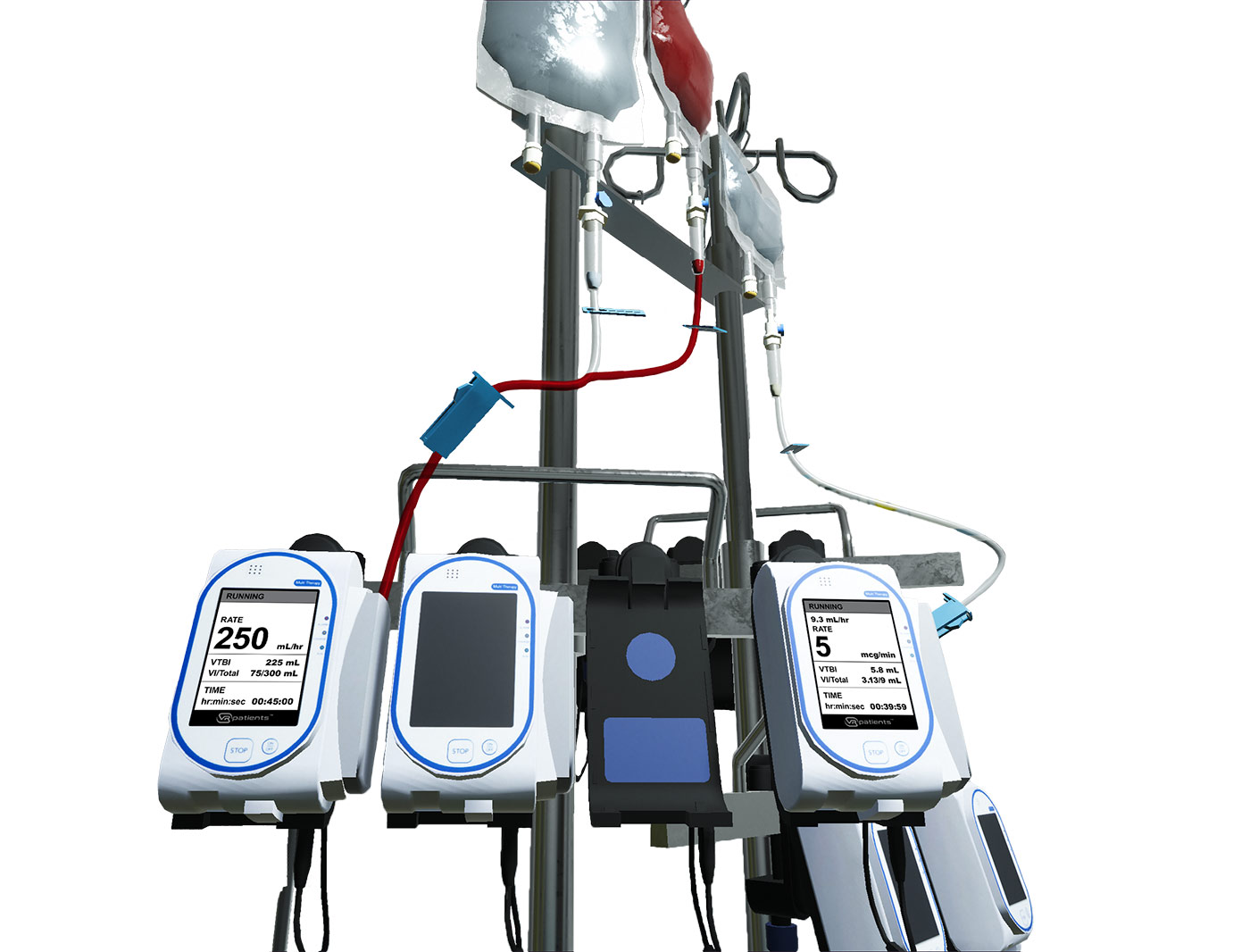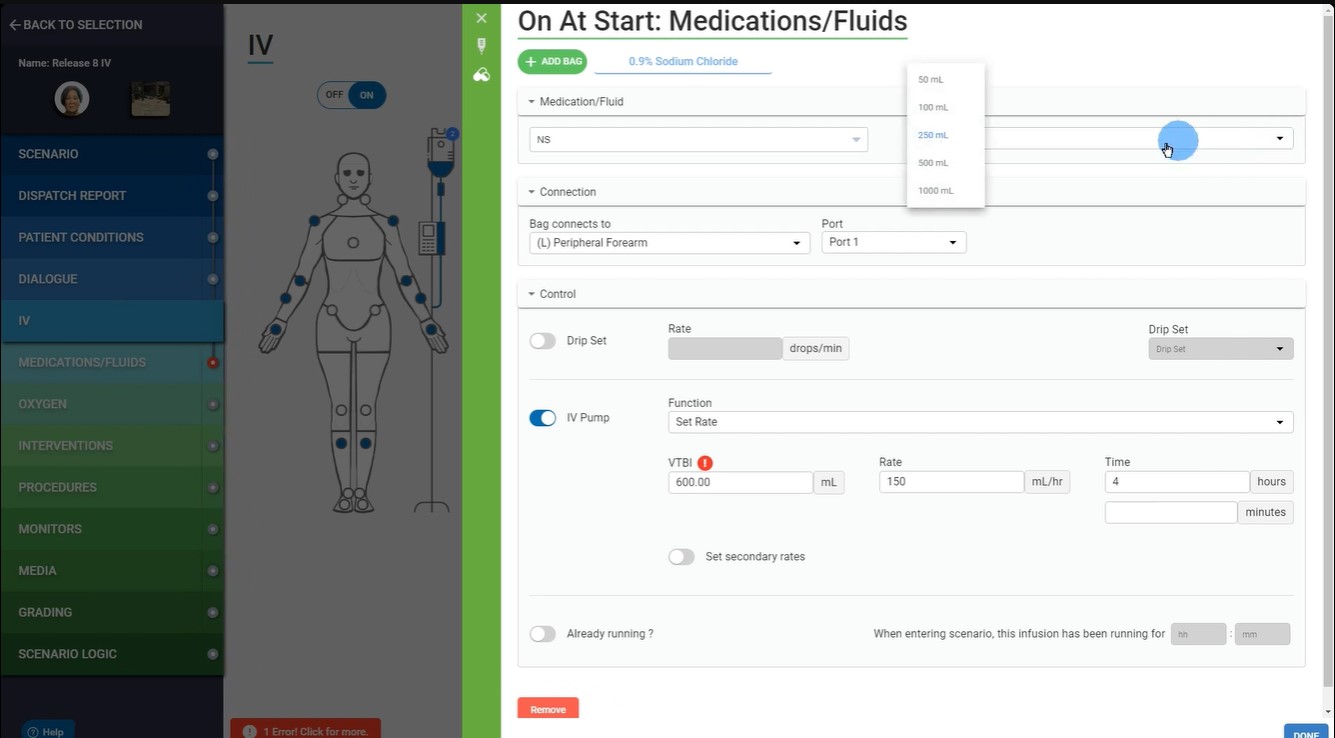Unpacking VRpatients’ Advanced Infusion Mechanics and Grading
The latest software upgrade to VRpatients contains all kinds of enhancements to help make training nurses and medical responders even more realistic.
The biggest change? The addition of infusions that look and act like the real thing.
“In previous versions, it was pretty much bare bones. You chose a medication and gave it to the patient in a certain way,” explains Reed Kaufman, product development lead for VRpatients. “Now we have concentrations where an amount of a medication can be added to an amount of something else and the student needs to figure out the math to make it work. For the students, it’s significantly closer to reality.”
Because there are many more choices a student needs to make, the release also includes improvements instructors can use to evaluate their students.

Grading Outputs
“There are several layers of calculations students need to make in order to make sure they’re getting this this stuff right,” Kaufman says. “This is where a lot of the danger of administering medications comes in. If you get any of these calculations wrong, you’ve messed up the dose and can harm a patient.”
VRpatients provides real life training without the real life consequences. Instructors can choose the grading output that suits the needs of a specific teaching point within a simulation.
“Earlier iterations didn’t do any if this. It didn’t force the student to make any of the calculations or do any of that type of work they have to do in the real world,” Kaufman says.
Luckily, this version includes a calculator to help students do the math.
The grading output can be:
- Total score only: Just success and failure and a percentage score.
- Score and points: This is what was included in previous versions of VRpatients.
- Detailed: Instructors can see each thing a student got correct and what they got wrong.
“The grading system is pretty comprehensive. The grading output adjustments were a user request. Instructors wanted to have the option for their students to see a more robust output at the end of the simulation,” Kaufman explains. “Now we’re giving instructors the option of showing a student everything they did so they can read through it all and maybe do the case again immediately and try to get things right.”
But the details are only there if the instructor wants them to be.
“Some instructors don’t want their students to have all of the detailed information because part of their training includes a debrief with an instructor after the simulation,” Kaufman says.
Other times, instructors want students to learn on their own and they need more details in order to do so.
“Or maybe they’re testing students and don’t want students seeing the outputs and what they got right and wrong because they have limited attempts to pass,” he says. “By giving the different grading output options to the instructors, they can decide how best to implement VRpatients simulations inside of their own curriculum.”
Undo Button
Another feature users wanted was a way to easily fix their mistakes when creating a new scenario.
Release 8 includes an undo button.
“Case logic can be dense and humans are fallible, so you can misclick. We wanted to have an undo option available so that in case you did something that you didn’t intend to, you can go undo whatever it is you just did,” Kaufman says.
On at Start
More and more nursing programs are using VRpatients, and as a result, the software needed to address a situation that is unique to them.
“A very interesting thing that we added with Release 8 is an ‘On at Start’ feature, which is something that we haven’t had at any point in time prior to this release,” Kaufman says.
Prior to this update, when a scenario began, nothing had been done to the patient and they hadn’t been treated in any way. It’s up to the student to evaluate and begin treatment.
“That’s probably true if you’re in EMS, right? You’re fresh to the scene and you have to figure out what is going on. But in a nursing environment, chances are a person is already in a gown, in a bed, and hooked up to an IV,” he explains. “So we added on at start so a patient can already have an IV on them when a student walks into a scenario. The patient has already been medicated and a nurse needs to figure out what is going on and adapt accordingly.”
That’s like the real world when shift changes happen or a patient presses a call button.
“They’re probably already hooked up to stuff and probably already have things going on, so it’s the nurse’s responsibility to deduce what’s happening and see what needs to be done.”
All of these changes have the end goal of providing a realistic experience in their training simulations.
Real life training without real life consequences with VRpatients.

You can see the new features in Release 8 for yourself by signing up for your own customized demo, whether you are an EMS Educator or a Nurse Educator. Already in our system? Send us an email to schedule a demo or send us a question. We can’t wait to hear from you!
